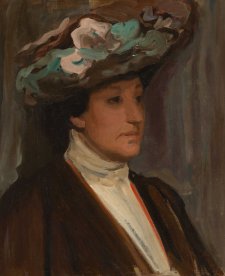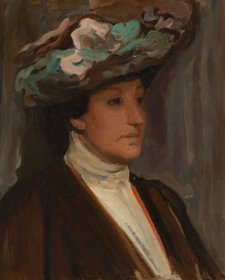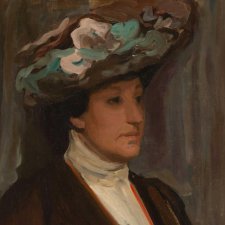Rupert Charles Wulsten Bunny (1864–1947) was one of the most celebrated Australian expatriate artists of his generation, achieving a degree of success in Paris in the 1890s and early 1900s that was unmatched by his peers. Born and raised in Melbourne, he studied at Melbourne's National Gallery School from 1881 to 1883 alongside artists such as Frederick McCubbin and John Longstaff, and travelled throughout Europe for two years as a young man, gaining a fluency in French and German that was vital to the furthering of his artistic career. Bunny departed for London in 1884, where he attended classes at St John's Wood Art School under Philip Calderon. Two years later, he enrolled in the Paris atelier of Jean-Paul Laurens, an academic history painter, before completing his training at Académie Colarossi in 1890 under Pierre Paul Léon Glaize. As a result, he mastered academic history painting (large scale, complex compositions based on mythological, historical and biblical subjects, typically involving multiple figures). Bunny often drew on the German myths and legends he had learned as a child from his German mother, and the biblical narratives and classical Greek and Roman myths taught to him by his English father. Exhibiting at the Parisian Salon de la Société des Artistes Français (Old Salon) from 1888, Bunny was the first Australian painter to receive an honourable mention, for his painting The Tritons.
During the same period Bunny also painted pastorals, blending the technical virtuosity required of history painting with the influence of French Symbolism, with its concern for the use of imagination to convey emotion through suggestion. Among Bunny’s other sources of inspiration were contemporary thought, music and poetry, the artist being a talented pianist and composer himself. It is said that Dame Nellie Melba, whom Bunny painted several times, would have liked him for her accompanist. In addition to his portraits of Melba – among them the fabulously imperious Madame Melba c. 1902 (held by the NGV) – Bunny created portraits of a number of Europe-based Australian musicians and performers including Percy Grainger and Ada Crossley. He met his future wife, Jeanne Heloise Morel (1871–1933) in 1895. A fellow art student, Morel became the subject of many of Bunny's paintings, modelling for his iconic compositions capturing the idylls and leisured life of the Belle Epoque. Influenced by Morel, whom her married in 1902, and her friends, and also by the British pre-Raphaelite painters, Bunny's most recognised works include A summer morning c. 1908 (AGNSW Collection) and other, large-scale paintings depicting languid, dreaming female figures alone or in groups.
By the Parisian Autumn Salon of 1913, Bunny's works increasingly displayed heightened colour and compositional rhythm. Moving away from naturalism, his paintings of this period evidence the influence of Matisse and of the spectacle of the Ballet Russes productions. The late 1920s saw Bunny focus on landscape, a genre which previously had rarely captured his attention. Following the death of his wife in 1932, which occurred when Bunny was visiting Melbourne, he returned permanently to Australia. He joined the Melbourne contemporary art scene and exhibited with progressive artist groups as well as holding solo exhibitions in Melbourne and Sydney. In 1946 he was given a major retrospective in his hometown, which confirmed his reputation as one of Australia's most significant artists. Bunny died in 1946, aged 82.
Though his reputation in Australia waxed and waned during his career, this has since been interpreted as a reflection of ongoing debates about the character of Australian art, and the reluctance on the part of Australian audiences to value the work of Australian artists whose subject matter was not demonstrably 'Australian'. His reputation and his place in the canon of Australian art, however, has since been confirmed with several major retrospectives of his work. These include Rupert Bunny: An Australian in Paris at the then Australian National Gallery (National Gallery of Australia) in 1991–1992; and Rupert Bunny: Artist in Paris, curated by Deborah Edwards for the Art Gallery of New South Wales and which toured nationally in 2000. His work is held in collections in Australia and overseas, including thirteen works collected in France during his lifetime.







